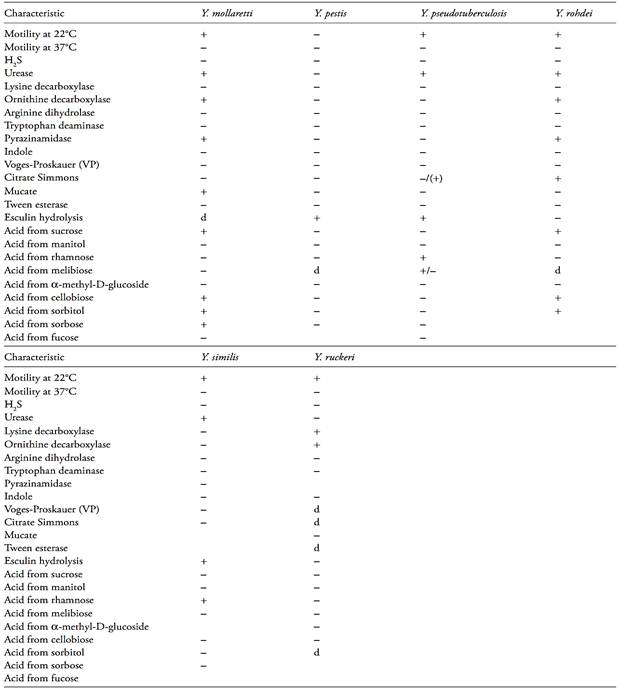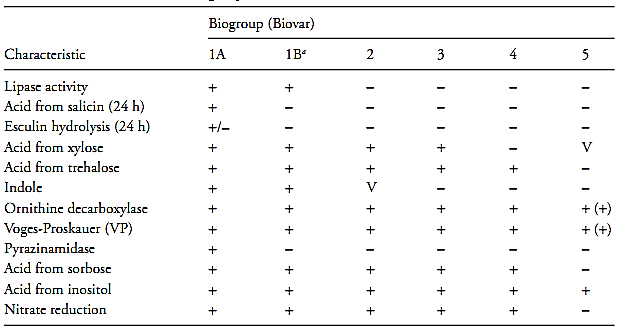


 النبات
النبات
 الحيوان
الحيوان
 الأحياء المجهرية
الأحياء المجهرية
 علم الأمراض
علم الأمراض
 التقانة الإحيائية
التقانة الإحيائية
 التقنية الحيوية المكروبية
التقنية الحيوية المكروبية
 التقنية الحياتية النانوية
التقنية الحياتية النانوية
 علم الأجنة
علم الأجنة
 الأحياء الجزيئي
الأحياء الجزيئي
 علم وظائف الأعضاء
علم وظائف الأعضاء
 الغدد
الغدد
 المضادات الحيوية
المضادات الحيوية|
Read More
Date: 9-3-2016
Date: 9-3-2016
Date: 9-3-2016
|
Yersinia enterocolitica
1. Introduction
Yersinia enterocolitica and Yersinia pseudotuberculosis are pathogenic bacteria that cause foodborne diseases classified by the International Commission on Microbiological Specifications for Foods (ICMSF, 2002) in risk group II: “diseases of serious hazard, incapacitating but not life threatening, of moderate duration with infrequent sequelae”.
1.1 Taxonomy
According to the 2nd Edition of Bergey’s Manual of Systematic Bacteriology (Bottone et al., 2005), Yersinia is a genus of the family Enterobacteriaceae and are defined as rod-shaped to coccobacilli, Gram-negative bacteria, that are further facultative anaerobes, oxidase-negative, catalase-positive, and, usually, urease and nitrate positive. They ferment glucose with little or no gas production and are psychrotrophic in nature, with an optimal growth temperature between 28 and 29°C. They are biochemically more active at 28 than at 37°C, and their properties that are most influenced by the temperature are motility, production of acetyl methyl carbinol (VP test), ornithine decarboxylase activity, β-galactosidase activity, production of indole, use of citrate and fermentation of cellobiose and raffinose, more constantly expressed at 28°C. The main characteristics of the eleven Yersinia species included in the 2nd Edition of Bergey’s Manual of Systematic Bacteriology are described in Table 1. After the publication of the 2nd Edition of Bergey’s Manual of Systematic Bacteriology four new species are included in the genus:
Yersinia aleksiciae Sprague and Neubauer 2005, sp. nov, consisting of five strains originally phenotyped as Y. kristensenii. Yersinia similis Sprague et al. 2008, sp. nov., consisting of six Yersinia isolates originally phenotyped as Y. pseudotuberculosis. Yersinia massiliensis Merhej et al. 2008 emend. Souza et al. 2011, sp. nov., consisting of two new strains isolated from fresh water in Marseilles, France Yersinia entomophaga Hurst et al. 2011, sp. nov. consisting of one new strain isolated from diseased larvae of the New Zealand grass grub, Costelytra zealandica (Coleoptera: Scarabaeidae).
Y. enterocolitica is a heterogeneous species, the strains of which can be subdivided into biotypes (based on bio-chemical characters) and serotypes (based on somatic and flagellar serological characteristics). Several bio-typing schemes have been developed over the years, most of which are outdated by now. The 2nd Edition of the Bergey’s Manual of Systematic Bacteriology (Bottone et al., 2005) divides the strains into six biotypes, based on the phenotypic characteristics described in Table 2. Biotyping and serotyping are important in epidemiological investigations, since not all biotypes or serotypes are pathogenic. For this reason, it is advisable that all the strains isolated from foods suspected of involvement in outbreaks be sent to a Yersinia reference laboratory, which is familiar with the biotyping and serotyping schemes currently in use. Up to the present moment, the biotypes most commonly implicated in outbreaks of yersiniosis are the biotype 4 of serotype 0:3 (gastrointestinal infections in Europe, Canada, South Africa and, more frequently, in the United States), serotype O:8 (up to now the most frequently isolated in the United States, although at diminishing frequency, it has been sporadically reported in other parts of the world also), and serotype O:9 (the second most common in Europe and Japan).
Table.1 Differential characteristics of the species of the genus Yersinia (Euzéby, 2008).


+ = positive, − = negative, +/− = most strains positive, −/+ = most strains negative, d = variable among the strains, (+) = weak or delayed.
a Some strains isolated in New Zealand are ornithine-decarboxylase-negative and melibiose-positive. There are strains of Y. enterocolitica (biovar 2, serovar O:5) isolated in France which may be sucrose-negative. Some of these strains were isolated from sick people who present abdominal pain or diarrhea and the majority has the plasmid pYV.
b Some strains of biovar 5 are negative
Table.2 Differentiation of biogroups of Yersinia enterocolitica (Bottone et al., 2005).

+ = positive, – = negative, (+) = delayed positive, V = variable.
a Biogroup B comprised mainly of strains isolated in the United States.
1.2 Epidemiology
Three species of Yersinia are potentially pathogenic to man: Y. pestis, Y. pseudotuberculosis and Y. enterocolitica (Weagant and Feng, 2001). Y. pestis is the causative agent of the bubonic plague, but it is not transmitted by foods. Y. enterocolitica and Y. pseudotuberculosis cause gastroenteritis (FDA/CFSAN, 2012).
Yersiniosis caused by Y. enterocolitica and Y. pseudotuberculosis are characterized by acute diarrhea and fever (principally in young children), abdominal pain and acute mesenteric lymphadenitis, simulating appendicitis (in older children and adults). In some cases, complications may occur, such as nodous erythema (in about 10% of the adults affected, particularly women), post-infectious arthritis (in 50% of infected adults) and systemic infection. Bloody diarrhea may also occur in 10 to 30% of the children infected by Y. enterocolitica (InformeNet DTA, 2003).
The infective dose remains unknown but is estimated to be between 104 to 106 organisms. The incubation period is generally one to 11 days, occasionally several months. The greatest at-risk groups are children, debilitated or immunodepressed individuals and elderly people (FDA/CFSAN, 2012).
According to Informe-Net DTA (2003) the reservoir of these bacteria are animals, mainly swine, which carry Y. enterocolitica in the larynx or throat. Y. pseudotuberculosis is encountered in several avian and mammal species, including rodents and other small mammals. Both species are found in swine, birds, squirrels, cats and dogs. According to FDA/CFSAN (2012) Y. enterocolitica is not part of the normal human flora, but has been isolated from feces, wounds, sputum and mesenteric lymph nodes of human beings. Y. pseudotuberculosis has been isolated from the diseased appendix of humans.
Transmission occurs via the oral-fecal route by contaminated water and foods, or by contact with infected individuals or animals. Y. enterocolitica has been isolated from meats (pork, beef, lamb, etc.), oysters, fish, crabs, and raw milk. Raw or undercooked pork products are of particular concern. Refrigeration does not reduce the risk of trans-mission, because Y. enterocolitica is a psychrotrophic bacterium and multiplies in cold-stored foods (FDA/CFSAN, 2012). Hospital transmission has also been reported, as well as transmission through blood transfusion, both from asymptomatic donors or donors that had recently suffered from mild gastroenteritis (Informe-Net DTA, 2003).
References
Silva, N.D .; Taniwaki, M.H. ; Junqueira, V.C.A.; Silveira, N.F.A. , Nasdcimento , M.D.D. and Gomes ,R.A.R .(2013) . Microbiological examination methods of food and water a laboratory Manual. Institute of Food Technology – ITAL, Campinas, SP, Brazil .
Bottone, E.J., Bercovier, H. & Molaret, H.H. (2005) Genus XLI Yersinia. In: Brenner, D.J., Krieg, N.R. & Staley, J.T. (eds). Bergey’s Manual of Systematic Bacteriology. Volume 2. 2nd edition. New York, Springer Science+Business Media Inc. pp. 838–848.
Euzéby, J.P. (2008). Caractères bactériologiques des espèces du genre Yersinia. In: Euzéby, J.P. Dictionnaire de Bactériologie Vétérinaire. [Online] France. Available from http://www.bacterio.cict.fr/bacdico/yy/tbiochimiquesyersinia.html [Accessed 24th October 2011].
FDA/CFSAN (ed.) (2009) Foodborne Pathogenic Microorganisms and Natural Toxins Handbook “Bad Bug Book”. [Online] College Park, Food and Drug Administration, Center for Food Safety & Applied Nutrition. Available from: http://www.fda.gov/food/foodsafety/foodborneillness/foodborneillnessfoodbornepa-thogensnaturaltoxins/badbugbook/default.htm [Accessed 10th October 2011].
Hurst, M.R.H., Becher, S.A., Young, S.D., Nelson, T.L. & Glare, T.R. (2011) Yersinia entomophaga sp. nov., isolated from the New Zealand grass grub Costelytra zealandica. International Journal of Systematic and Evolutionary Microbiology, 61, 844–849.
ICMSF (International Commission on Microbiological Specifica-tions for Foods) (2002) Microorganisms in Foods 7. Microbiological Testing in Food Safety Management. New York, Kluwer Academic/Plenum Publishers.
INFORME-NET DTA, 2003. Manual das Doenças Transmitidas por Alimentos – Yersinia enterocolitica/Yersinia pseudotuberculosis [Online] São Paulo, Centro de Vigilância Epidemiológica (CVE). Available from: http://www.cve.saude.sp.gov.br/htm/hidrica/yersi_entero.htm [Accessed 10th May 2012].
International Organization for Standardization (2003) ISO 10273:2003. Microbiology of food and animal feeding stuffs - Horizontal method for the detection of presumptive pathogenic Yersinia enterocolitica. Geneva, ISO.
Merhej, V., Adékambi, T., Pagnier, I., Raoult, D. & Drancourt, M. (2008) Yersinia massiliensis sp. nov., isolated from fresh water. International Journal of Systematic and Evolutionary Microbiology, 58, 779–784
Souza, R.A., Falcão, D.P. & Falcão, J.P. (2011) Emended description of Yersinia massiliensis. International Journal of Systematic and Evolutionary Microbiology, 61, 1094–1097
Sprague, L.D. & Neubauer, H. (2005) Yersinia aleksiciae sp. nov. International Journal of Systematic and Evolutionary Microbiology, 55, 831–835.
Sprague, L.D., Scholz, H.C., Amann, S., Busse, H.J. & Neubauer, H. (2008) Yersinia similis sp. nov. International Journal of Systematic and Evolutionary Microbiology, 58, 952–958.
Weagant, S.D. & Feng, P. (2001) Yersinia. In: Downes, F.P. & Ito, K. (eds). Compendium of Methods for the Microbiological Examination of Foods. 4th edition. Washington, American Public Health Association. Chapter 41, pp. 421–428.



|
|
|
|
4 أسباب تجعلك تضيف الزنجبيل إلى طعامك.. تعرف عليها
|
|
|
|
|
|
|
أكبر محطة للطاقة الكهرومائية في بريطانيا تستعد للانطلاق
|
|
|
|
|
|
|
العتبة العباسية المقدسة تبحث مع العتبة الحسينية المقدسة التنسيق المشترك لإقامة حفل تخرج طلبة الجامعات
|
|
|